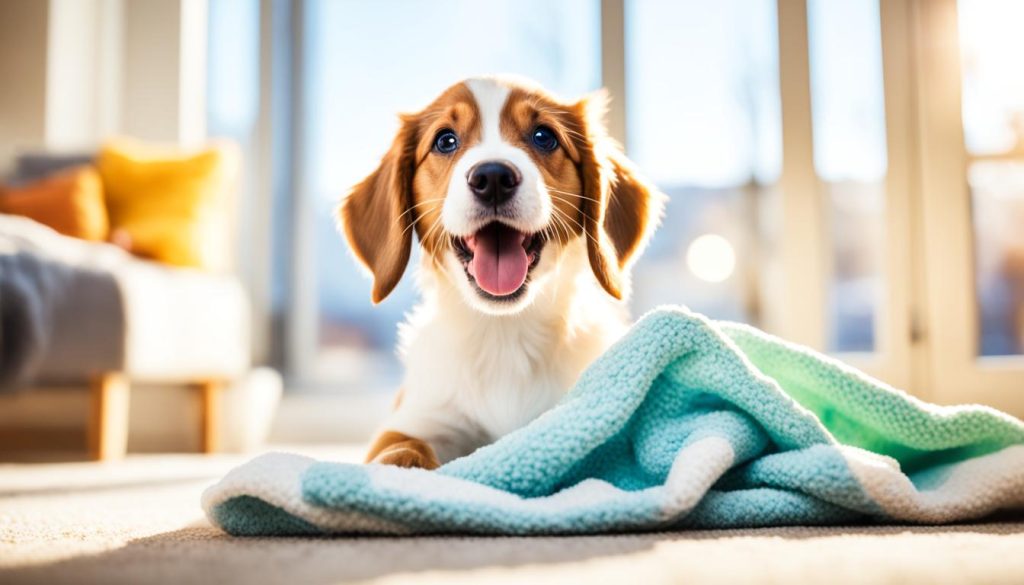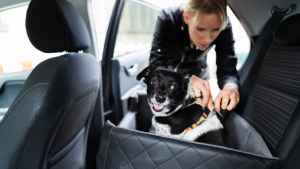Bringing home a new puppy is an exciting and joyful experience. As a pet owner, it’s your responsibility to create a loving and comfortable environment that will help your new canine companion settle into their new home. The first few days are crucial for building a strong foundation and establishing a lifelong bond with your furry family member.
Whether you’re adopting a new dog or welcoming a puppy into your family, these housebreaking tips and puppy training techniques will ensure a smooth transition and make your home a dog-friendly haven.

Key Takeaways:
- Introduce your puppy gradually to their new surroundings, minimizing stress and excitement.
- Establish a routine for mealtime, potty breaks, playtime, nap times, and bedtime to provide security and consistency.
- Survive the first night by creating a cozy sleeping space and following a bedtime routine.
- Build a strong bond with your puppy through affectionate contact, consistent rules, and rewards for good behavior.
- Help your puppy explore by introducing new sounds, environments, and experiences while ensuring their safety.
Introducing Puppy to a New Home
When bringing a puppy home, it’s essential to ensure a smooth and comfortable transition for them. Introducing them to their new surroundings gradually can help minimize stress and create a positive experience. Here are some tips to help you introduce your puppy to their new home:
- Limit their access: To prevent overwhelming your puppy, it’s best to start by confining them to a small, puppy-proofed area in your home. This will allow them to acclimate to their new surroundings gradually.
- Choose a designated potty spot: Establishing a specific area outside your home for your puppy to go potty will help them understand where it’s appropriate to relieve themselves.
- Meet the family one at a time: Introduce your puppy to each family member individually, allowing them to become familiar with each person’s scent and presence. This approach can help your puppy feel more comfortable and secure.
- Minimize stress and excitement: While it’s natural to be excited about your new furry family member, it’s important to create a calm and peaceful environment for your puppy. Avoid overwhelming them with too much activity or noise.
- Introduce other pets gradually: If you have existing pets at home, introduce them to your new puppy slowly and under supervised conditions. This will allow everyone to adjust to each other’s presence and minimize any potential conflicts.
- Enforce rules from the beginning: Establishing house rules and boundaries right from the start will help your puppy understand what is expected of them. Consistency is key in reinforcing these rules.
- Schedule a veterinary appointment: It’s important to have your puppy examined by a veterinarian shortly after bringing them home. This will ensure they are healthy and up-to-date on vaccinations.
By following these tips, you can help your new puppy feel more secure and settled in their new home.
Start a Routine and Stick to It
Establishing a routine is crucial for your new puppy’s well-being and development. A structured routine helps them feel secure and understand what’s expected of them. Consistency is key to fostering a sense of stability and setting your furry friend up for success. Here are some guidelines to help you create a routine for your puppy’s mealtime, potty breaks, playtime, nap times, and bedtime.
Mealtime
Set specific meal times for your puppy to ensure they receive proper nutrition and avoid overeating. Feed them in a quiet area of your home, away from distractions. Remember to provide fresh water at all times.
Potty Breaks
Determine a regular schedule for potty breaks, especially after mealtimes, play sessions, and nap times. Take your puppy to their designated potty spot and patiently wait for them to relieve themselves. Reinforce positive behavior with praise and rewards.
Playtime
Adequate exercise and playtime are essential for your puppy’s physical and mental stimulation. Engage in interactive play sessions, such as chasing toys or playing fetch. Consider age-appropriate toys that are safe for your puppy to chew on.
Nap Times
Puppies need plenty of rest to support their growth and development. Provide a comfortable and quiet space for your puppy to relax and take naps throughout the day. Avoid disturbing them during their nap times.
Bedtime
Establish a consistent bedtime routine to help your puppy wind down and prepare for a good night’s sleep. Create a cozy sleeping area, such as a crate or a dog bed, in a quiet location. Consider placing a familiar blanket or toy to provide comfort and security.
Remember, every puppy is unique, and their routine may need adjustments based on their age, breed, and individual needs. It may take some time for your puppy to adjust to the routine, but with patience and consistency, they will thrive in their new home.
Surviving the First Night
The first night can be a daunting experience for both you and your new puppy. Adjusting to a new home can be challenging, but with the right strategies, you can help your furry friend settle in comfortably and make it through the night smoothly.
Settling In
When you bring your puppy home, it’s essential to create a welcoming environment. Provide a comfortable crate where they can feel secure and cozy. For added reassurance, consider placing the crate in your bedroom during the first night to provide extra security and proximity.

Bedtime Routine
Establishing a consistent bedtime routine is key to help your puppy understand when it’s time to sleep. Designate a specific area for their crate, keeping it quiet and free of distractions. Before bedtime, engage in calming activities such as gentle play or a short walk to help your puppy wind down.
Handling Potty Breaks
Puppies have small bladders and may need to relieve themselves during the night. To avoid disrupting their sleep, take them outside for a potty break right before bedtime. If they wake up during the night, keep the interactions quiet and calm. Take them to their designated potty spot, encouraging them to do their business quickly, and then return them to their crate without unnecessary stimulation.
By implementing these tips, you can help your puppy settle in and reduce their anxiety during the first night. Remember to provide plenty of patience, love, and reassurance as they adjust to their new home.
Building Strong Bonds
Building a strong bond with your new puppy is essential for a happy and healthy relationship. By establishing a deep and affectionate connection, you can nurture a lifelong bond that will bring joy and companionship to both you and your furry friend.
To foster this bond, it’s important to prioritize affectionate contact with your puppy. Regularly shower them with love, cuddles, and gentle pats to make them feel secure and reassured. Physical touch can help build trust and strengthen the bond between you and your puppy.
Consistency is another key factor in forming a strong bond. Providing your puppy with a stable and predictable environment will help them feel safe and secure. Establishing and enforcing consistent rules from the beginning will also help your puppy understand boundaries and expectations.
Rewards for good behavior play an important role in building a bond with your puppy. Positive reinforcement, such as treats and praise, can be used to reinforce desirable behaviors and encourage mutual trust and respect. Rewarding your puppy for their good behavior will motivate them to continue behaving well and deepen the connection between you.
Remember, building a bond with your puppy is an ongoing process that requires time, patience, and understanding. By prioritizing affectionate contact, consistent rules, and rewards for good behavior, you can establish a strong and lasting bond that will bring you both joy and fulfillment.
https://www.youtube.com/watch?v=iPZNSk2n_KE
Introduce New Sounds and Help Your Puppy Explore
As your puppy adjusts to their new surroundings, it’s important to gradually introduce them to new sounds and help them explore different environments. This will help them become more confident and adaptable in various situations.
Introducing Sounds: Start by exposing your puppy to different sounds in a controlled and positive way. You can play recordings of common household noises, such as vacuum cleaners or doorbells, at a low volume to familiarize them with these sounds. Gradually increase the volume over time as they become more comfortable.
Exploring Environments: Take your puppy on regular walks and let them explore different environments. This will help them become accustomed to new sights, sounds, and smells. Allow them to investigate at their own pace and reinforce positive behavior with treats and praise.
Traveling in the Car: To get your puppy used to car rides, start with short trips around the neighborhood. Gradually increase the duration and distance of the car rides. Make sure to use a crate or a secure harness to keep them safe during travel.

Getting Used to Handling: Regularly handle your puppy’s paws, ears, and mouth to help them become familiar with being touched. This will make grooming, vet visits, and everyday handling easier for both of you.
Using a Crate: Provide your puppy with a crate as a safe and comfortable space. Encourage them to enter willingly and make it a positive experience with treats and a cozy blanket. A crate can help with housebreaking, provide a sense of security, and serve as a place for your puppy to relax and sleep.
Make Things Familiar for the New Puppy
Making a new puppy feel at home is essential for their well-being and comfort. To ease their transition, it’s important to make things familiar for them. One way to achieve this is by bringing items that carry the scent of their mother and littermates. These familiar scents provide a sense of comfort and security for the puppy as they adjust to their new environment.
Bringing a blanket, towel, or toy that smells like their previous home can help ease any anxiety or stress they may be feeling. Placing these items in their designated sleeping area or near their crate can provide a sense of familiarity and make them feel more at ease.
Additionally, it’s crucial to allow the puppy to dictate the pace of interactions. Every puppy is unique and may have different comfort levels when it comes to socializing. It’s important not to force them into overwhelming situations or introduce them to too many new people or animals at once. Giving them time to adjust and approach new experiences gradually is key.
By making things familiar and allowing the puppy to dictate their interactions, you can help create a nurturing and comforting environment for your new furry family member. This will set the foundation for a positive and trusting relationship as they grow and explore their new home.
Create Rules for Your Puppy’s First Day at Home
Establishing rules for the puppy’s first day at home is crucial for their development and well-being. Consistency and clear house rules provide structure and guidance, setting the foundation for a happy and harmonious relationship with your new furry friend.
One of the first rules to establish is regarding appropriate chew items. Puppies have a natural instinct to chew, which helps with teething and relieves anxiety. To protect your belongings and promote good oral health, provide your puppy with suitable chew toys. Look for durable options designed specifically for puppies, such as rubber or nylon toys. Avoid items that could be easily swallowed or pose a choking hazard.
Puppy-proofing the house is another important rule to follow. Just like toddlers, puppies are curious and can get into mischief. Safeguard your home by securing electrical cords, keeping toxic substances out of reach, and removing any small objects that could be swallowed. Close off areas that are off-limits to the puppy and use baby gates if necessary.
Setting boundaries for your puppy’s behavior is crucial for their training and safety. Clearly define what is allowed and what is not. For example, establish rules about staying off furniture, entering certain rooms, or jumping on people. Be consistent in enforcing these rules from day one to avoid confusion and establish good habits.
Remember, the key to successful rule establishment is consistency. Stick to the rules you set and provide clear and gentle guidance to help your puppy understand what is expected of them. With time, patience, and love, your new furry companion will learn and grow within the boundaries of your household rules.
https://www.youtube.com/watch?v=sZEeKbx-TBM
Conclusion
Bringing a new puppy home is an exciting and important event. The first day plays a crucial role in establishing a strong foundation for their lifelong journey together. By following the tips and guidelines provided in this article, you can ensure that your puppy’s first day is enjoyable and comfortable for both of you.
Settling in takes time and patience. Creating a happy home environment begins with introducing your puppy to their new surroundings gradually and making things familiar for them. By bringing items that carry the scent of their mother and littermates, you can provide a sense of security and comfort. Allowing the puppy to dictate the pace of interactions and using positive reinforcement will help them feel safe and loved.
Building a lifelong bond is key to a successful relationship with your furry friend. This involves consistent rules, rewards for good behavior, and affectionate contact. By establishing a routine and sticking to it, you can provide structure and guidance for your puppy’s development. Remember, the journey of building a lifelong bond will be filled with joy, challenges, and countless memories.
As you embark on this new chapter with your puppy, remember that each day is an opportunity to strengthen your bond and create a happy home. Enjoy the journey, cherish the moments, and embrace the unconditional love that your new companion brings to your life.